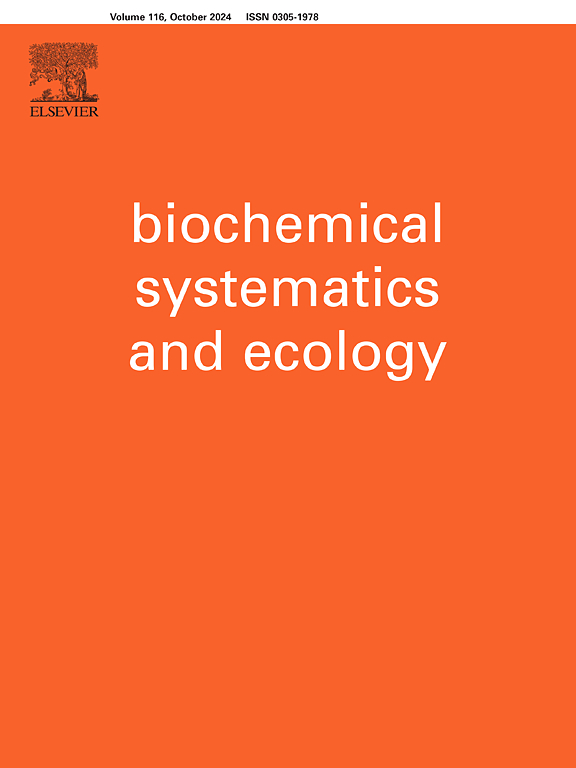利用红外线和质谱法鉴别不同阶段的芨芨草叶中的代谢物
IF 1.4
4区 生物学
Q4 BIOCHEMISTRY & MOLECULAR BIOLOGY
引用次数: 0
摘要
巴西胡椒树(Schinus terebinthifolia Raddi)是一种药用植物,具有多种生物活性,其中最重要的是抗炎、抗菌和抗增生。因此,需要对其生物活性化合物进行科学研究和调查。从三种不同的 S. terebinthifolia 基因型中采集了处于三个发育阶段的叶片。制备甲醇提取物,并用红外线和质谱进行分析。获得的数据经主成分分析(PCA)处理。应用于质谱数据的 PCA 模型被证明能有效区分三个发育阶段,此外还表明基因型在生产次生代谢物方面有不同的趋势。描述红外光谱数据的方差需要两个主成分(81.96%),而质谱数据需要三个主成分(55.73%)。有十种物质对分组(嫩叶、中叶和老叶或基因型 A、B 和 C 之间的区分)的影响最大,重点是二没食子酸甲酯、喹酸六苷、二没食子酸和没食子酸甲酯。红外光谱数据使我们能够区分嫩叶和中叶,对这种区分影响最大的光谱带(与 O-H、C-O、CC、C-H 和 CO 组相关)与质谱法显示的物质相关。这些结果表明,不同发育阶段的叶片中化合物的分布不同,为那些旨在分离特定生物物质的人提供了宝贵的信息。本文章由计算机程序翻译,如有差异,请以英文原文为准。
Use of infrared and mass spectrometry for the discrimination of metabolites from different stages of Schinus terebinthifolia Raddi leaves
The Brazilian Peppertree (Schinus terebinthifolia Raddi) is a medicinal plant with several biological activities, the most important of which are anti-inflammatory, antimicrobial and antiproliferative. Therefore, scientific research and investigation of its bioactive compounds are required. Leaves at three development stages were collected from three different genotypes of S. terebinthifolia. Methanol extracts were prepared and analyzed by infrared and mass spectrometry. The data obtained were treated by principal component analysis (PCA). The PCA model applied to the mass spectrometry data proved to be efficient to discriminate the three stages of development, in addition to indicating a differentiated tendency in the production of secondary metabolites by the genotypes. Two principal components were needed to describe the variance of the infrared spectrometry data (81.96%), while for mass spectrometry data three principal components were needed (55.73%). Ten substances were the most influential in the separation of the groups (young, intermediate, and old leaves or differentiation between genotypes A, B, and C), with emphasis on methyl digallate, quinic acid hexoside, digallic acid, and methyl gallate. Infrared spectroscopy data allowed us to differentiate young leaves from intermediate ones and the spectral bands that most influenced this differentiation (related to the groups O–H, C–O, C![]() C, C–H and C
C, C–H and C![]() O) correlated with the substances indicated by mass spectrometry. These results showed a different distribution of compounds among the leaf development stages, providing valuable information for those aiming to isolate specific substances of biological interest.
O) correlated with the substances indicated by mass spectrometry. These results showed a different distribution of compounds among the leaf development stages, providing valuable information for those aiming to isolate specific substances of biological interest.
求助全文
通过发布文献求助,成功后即可免费获取论文全文。
去求助
来源期刊

Biochemical Systematics and Ecology
生物-进化生物学
CiteScore
3.00
自引率
12.50%
发文量
147
审稿时长
43 days
期刊介绍:
Biochemical Systematics and Ecology is devoted to the publication of original papers and reviews, both submitted and invited, in two subject areas: I) the application of biochemistry to problems relating to systematic biology of organisms (biochemical systematics); II) the role of biochemistry in interactions between organisms or between an organism and its environment (biochemical ecology).
In the Biochemical Systematics subject area, comparative studies of the distribution of (secondary) metabolites within a wider taxon (e.g. genus or family) are welcome. Comparative studies, encompassing multiple accessions of each of the taxa within their distribution are particularly encouraged. Welcome are also studies combining classical chemosystematic studies (such as comparative HPLC-MS or GC-MS investigations) with (macro-) molecular phylogenetic studies. Studies that involve the comparative use of compounds to help differentiate among species such as adulterants or substitutes that illustrate the applied use of chemosystematics are welcome. In contrast, studies solely employing macromolecular phylogenetic techniques (gene sequences, RAPD studies etc.) will be considered out of scope. Discouraged are manuscripts that report known or new compounds from a single source taxon without addressing a systematic hypothesis. Also considered out of scope are studies using outdated and hard to reproduce macromolecular techniques such as RAPDs in combination with standard chemosystematic techniques such as GC-FID and GC-MS.
 求助内容:
求助内容: 应助结果提醒方式:
应助结果提醒方式:


